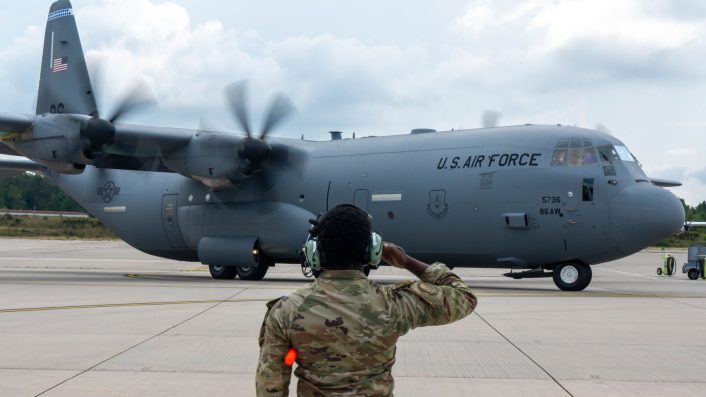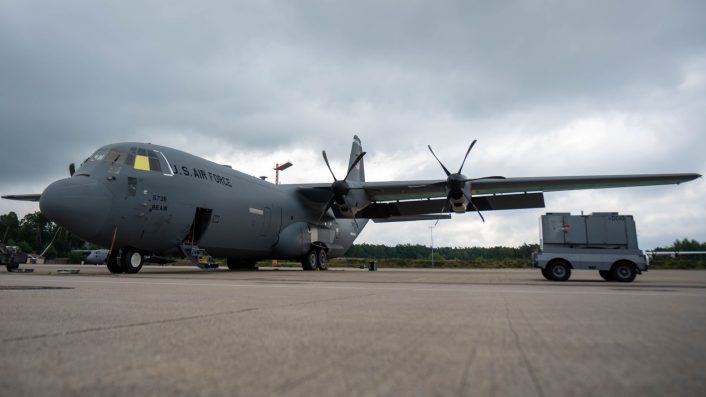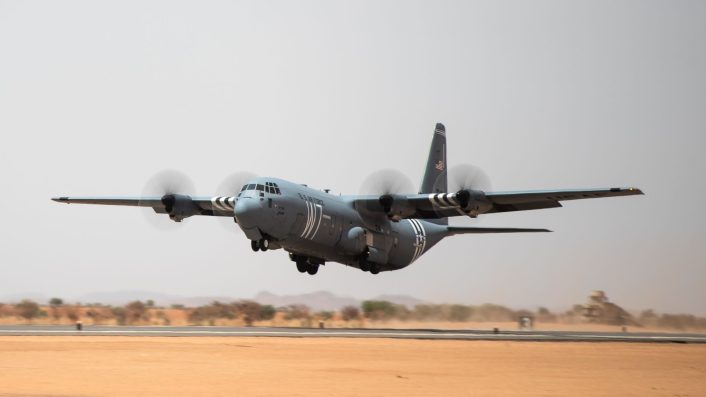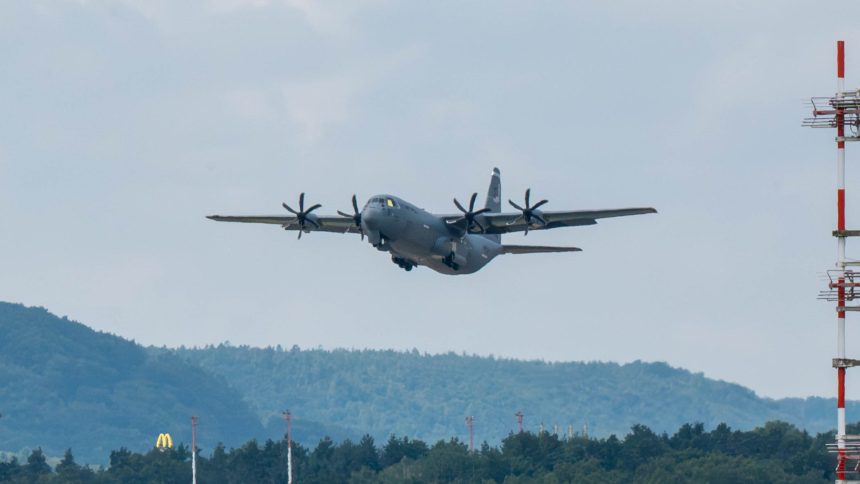A hard landing at Ramstein Air Base in 2020 damaged a C-130J’s structural integrity, which led to it becoming the first of the type to receive a wing replacement in the field.
A C-130J Super Hercules flew again with a new pair of wings on Jul. 26, 2025, after being grounded for five years at Ramstein Air Base, Germany. The aircraft, assigned to the 37th Airlift Squadron (37th AS), 86th Airlift Wing (86th AW), sustained extensive damage to its wings and structure following a hard landing at Ramstein on Apr. 23, 2020.
A press release from the 86th AW explained that, besides the production of the new wings, the work also required transport containers to be manufactured to move the wings from the U.S. to Ramstein. The statement stressed that this is the first such wing replacement for a ‘J’ variant of the C-130 on the field.
The C-130J, tail number 11-5376, is now back at Robins AFB, Georgia, home to the 402nd Expeditionary Maintenance Squadron (402nd EMS) and the 86th Maintenance Group (86th MG). While at Ramstein, the two units “spent over 30 days replacing the wings, engines and other main components of the aircraft,” explained the service.

The reason for the extensive repairs was that the hard landing in 2020 “damaged the structural integrity of the wings, engines and landing gear assemblies, rendering it unable to fly,” explained the press release. A subsequent AAIB (Aircraft Accident Investigation Board) report determined pilot error as the cause.
While no casualties or injuries were reported, the mishap was found to be attributed to pilot error. In fact, the AAIB found that the Mishap Pilot reduced engine power (or throttle), while coming in for landing, from an altitude higher than the one stipulated, which was considered unsuited for the C-130J’s flight characteristics.
Wing replacement and return to flight
The press release quoted 86th MG commander Col. Lucas Buckley, who said the C-130’s program office determined “that it would be more cost effective to return the aircraft” instead of divesting the airframe, and thus kickstarted the project. “Between the engineers, planners and technicians, taking the steps to put the aircraft back together was the best investment for the Air Force,” Buckley said.

The next four years saw new wings and the “first-of-its-kind” C-130J wing transport containers being constructed. These were then transported to Ramstein AB, where the 402nd EMS and the 86th MXG got to work on the core replacement effort. Buckley credited a “lot of helping hands” in the effort to return 5736 to flying standards, which were involved in “planning, engineering, handling and shipping of the wings from the United States to Ramstein Air Base.”
Months of planning, executing and repairs resulted in the aircraft 5736 conducting its first test flight in five years on Jul. 15, 2025. Some more tweaks and checks followed, and the C-130J finally flew “back home to the USA in the morning of July 28, 2025,” added the release, although the captions and the VIRIN naming of the photos state the flight happened on July 26.
The official images however don’t show the wing replacement effort, or the transport of the new wings to Ramstein from the continental United States.
The U.S. Air Force uses about 300 C-130 of the H and J variants as the mainstay of its tactical airlift capability, in addition to tens of aircraft configured for special missions. Over 560 airframes of the C-130J variant are in use in 23 countries, collectively logging over 3 million flight hours.
On Jun. 18, 2025, manufacturer Lockheed Martin also announced that the expected life of the C-130J Super Hercules’s wing is now at 122,500 EFH (Equivalent Flight Hours), instead of the previously calculated 90,000 EFH. This was revealed following a multi-year Wing Durability Test program funded by the U.S. Air Force and the Royal Canadian Air Force. The test “pushed the wing to its limits by simulating the stresses and strains of real-world flying conditions,” said Lockheed Martin.

C-130J mishap and cause
On the day of the incident on Apr. 23, 2020, the 37th AS was conducting a “routine periodic evaluation flight” for the Mishap Pilot 1 (MP1), which involved a “maximum effort takeoff, maximum effort (assault) landing, full stop, and then rejoin a formation” to complete the remainder of the evaluation. The incident took place during the landing portion of the exercise.
As per the AAIB report, the MP1 (Mishap Pilot 1) performed an “early engine power reduction (power pull)” while at 70 feet AGL (Above Ground Level) and set fully FLT IDLE (Flight Idle) at 45 feet AGL. However, this should have happened at approximately 20 feet AGL.
“Due to the aerodynamics of the C-130J, a reduction in power will exacerbate the sink rate, due to the fact the C-130J propellers generate high velocity airflow over the wings, directly affecting lift,” the AAIB explained in its report.
The vertical acceleration load factor (g-load) was 3.62 times the force of gravity (3.62g) and the landing sink rate was 834 feet per minute (FPM), exceeding the C-130J’s limit of 2.0g and 540 FPM. AAIB investigators also ruled out the crew’s belief that increased tailwind played a part in the increased sink rate.
Both the pilots failed to identify and arrest in a timely manner the excessive sink rate, “substantially contributing” to the C-130J-30 exceeding its g-load and sink rate landing limits. The AAIB report identified the damaged parts as the “center wing, both outer wings, left and right main landing gear assemblies, and engines, to include mounting structures,” putting the value of the damages at $20.9 million.

Efforts paid off
The press release noted the “complete team effort” was a result of successful coordination between the “C-130 program office, engineers, depot, MAJCOM (Major Command) staff and of the maintainers of the 86th AW that took care of the aircraft for the past 5 years.”
Eighty-Sixth MXG’s quality assurance superintendent Senior Master Sgt. Justin Jordan highlighted the effort’s testimony about the Air Force’s “capabilities […] resilience, technical expertise, and commitment to operational excellence.” In an emotional reflection, Jordan said watching the C-130J lift off was “like watching a dream take flight.”
Herculean Walk! 6 U.S. Air Force C-130J Super Hercules from the 86th Airlift Wing taxi down the flightline, Ramstein Air Base, Germany, Feb. 13, 24.The 86th AW flexed its ability to defend U.S. interests. 📷 Senior Airman Andrew Bertain #avgeeks #aviationlovers (Airman Magazine) pic.twitter.com/40XtQrTMQD
— Stealthy (@stealthy360) June 13, 2025
“It wasn’t just a mechanical achievement, it was a deeply personal moment,” explained Jordan. “Aircraft 5736 became more than just a machine to us; she represented resilience, history and the spirit of aviation. That first flight was a tribute to everyone who believed in her and worked tirelessly to bring her back to life. I’ll never forget the sound of her engines roaring to life and the sight of her wheels leaving the ground. It was magic!”









